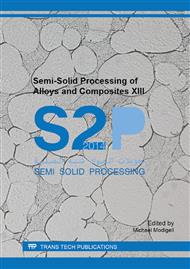[1]
M. Zaenz de Meira, M. Curioni, P. Skeldon and G.E. Thompson, The behaviour of second phase particles during anodizing of aluminium alloy, Corrosion Science, 52 (2010) 2489-2497.
DOI: 10.1016/j.corsci.2010.03.029
Google Scholar
[2]
I. Tsangaraki-Kaplanoglou, S. Theobari, Th. Dimogerontaki, N. Kallithrakas-Kontos, Yar-Ming Wang, Hong-Hsiang (Harry) Kuo, and Sheila Kia, Effect of alloy types on the anodizing process of aluminium, Surface and Coatings Technology, 200 (2006).
DOI: 10.1016/j.surfcoat.2005.02.174
Google Scholar
[3]
H. Möller, U.A. Curle and E.P. Masuku, Characterization of surface liquid segregation in SSM-HPDC aluminium alloys 7075, 2024, 6082 and A201, Trans. Nonferrous Met. Soc China 20(2010) 847-851.
DOI: 10.1016/s1003-6326(10)60593-6
Google Scholar
[4]
L. Chauke, H. Möller, G. Govender, Anodising of Al-Mg-Si-(Cu) alloys produced by R-HPDC, Materials Science Forum, 765 (2013) 658-662.
DOI: 10.4028/www.scientific.net/msf.765.658
Google Scholar
[5]
G. Govender and H. Möller, Evaluation of surface chemical segregation of semi-solid cast aluminium alloy A356, Solid State Phenomena, 141-143 (2008) 433-538.
DOI: 10.4028/www.scientific.net/ssp.141-143.433
Google Scholar
[6]
M. Jariyaboon, P. Moller, R.E. Dunin-Borkowski and R. Ambat, FIB-SEM investigation of trapped intermetallic particles in anodic oxide film on AA1050 aluminium, Anti-corrosion Methods and Materials 58/4 (2011) 173-178.
DOI: 10.1108/00035591111148885
Google Scholar
[7]
F. Apachitei, L.E. Terryn, H. Skeldon, P. Thompson, G.E. Duszczyk, J. Katgerma and L. Katgerman, Infuence of substrate microstructure on the growth of anodic oxide layers, Electrochimica Acta, 49 (2004) 1127-1140.
DOI: 10.1016/j.electacta.2003.10.024
Google Scholar
[8]
Y. Ma, X. Xhou, G.E. Thompson, M. Curioni, X. Xhong, E. Koroleva, P. Skeldon, P. Thompson and M. Fowles, Discontinuities in the porous anodic film formed on AA2099-T8 aluminium alloy, Corrosion Science 53(2011) 4141-4151.
DOI: 10.1016/j.corsci.2011.08.023
Google Scholar
[9]
A. Forn, I. Espinosa, M.T. Baile, E. Ruperez, Anodizing of A356 T6 Alloys obtained by Sub-Liquidus casting, Solid State Phenomena, 141-143 (2008) 755-760.
DOI: 10.4028/www.scientific.net/ssp.141-143.755
Google Scholar
[10]
U.A. Curle, H. Möller and G. Govender, R-HPDC in South Africa, Solid State Phenomena, 192-193 (2013) 3-15.
DOI: 10.4028/www.scientific.net/ssp.192-193.3
Google Scholar


